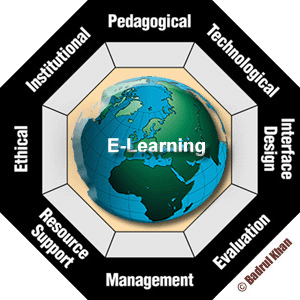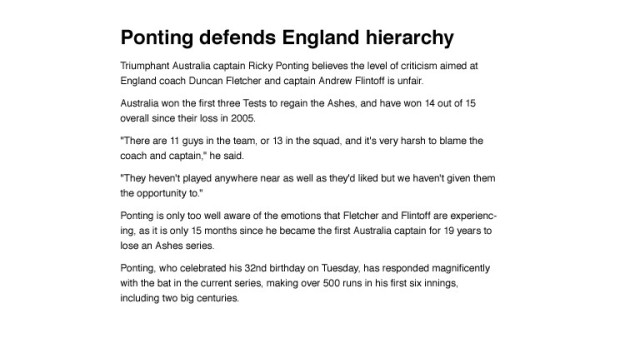Following is a review of “The MOOC Case Book: Case Studies in MOOC Design, Development and Implementation” the second-place winner of the Association for Educational Communications and Technology (AECT)’s Division of Distance Learning (DDL) Book Award, 2016.
The “MOOC Case Book” is a collection of case studies written by (mostly) educators sharing their experiences developing, delivering, and supporting a Massive Open Online Course (MOOC) from the perspective of one of eight dimensions of Khan’s e-learning framework. Khan’s Framework provides structure to the daunting task of developing a MOOC. Not only from a course design perspective but by providing strategies for the host of factors that impact the success of a MOOC. Factors associated with the Technological dimension for instance that involve the MOOC’s platform features, and the Institutional dimension that encompasses student services such as academic advising or institution policies. There’s also the dimension of Resource Support which addresses support for faculty in course design and technical online support for students. Details of Khan’s Framework are covered in chapter two; the image below provides a snapshot.
The book is geared to readers involved in developing or facilitating a MOOC. It provides guidance and knowledge; readers can learn from the experiences of chapter-authors who have ‘been-there-and-done-that’—who have invested the time and energy needed to pull a MOOC together. Included in the studies are two written from the student perspective, providing further depth to the stories shared. Readers interested in learning how institutions and educators are using digital platforms to deliver online learning—the methods, challenges and barriers faced, will find the studies within instructive, even entertaining.
Following is an overview of Khan’s Framework and highlights of a handful of the case studies. One disclaimer, I wrote one of the case studies—chapter #3 “Pedagogy and MOOCs: Practical Applications of Khan’s E-Learning Framework”. The chapter, as the title suggests, focuses on the Pedagogical dimension of the Framework.
About Khan’s Framework
As an instructional designer I’ve often heard from faculty and design teams the drawbacks of using a model (instructional design models such as ADDIE or the Dick, Carey & Carey model) for the instructional design process. Drawbacks mentioned include words such as, ‘cumbersome’, ‘too linear’, rigid’, and ‘inhibits creativity’. Khan’s Framework is different from traditional design models; it’s holistic. Not only does it address the design phase, but goes beyond by including elements critical to a MOOC’s success and sustainability. It expands to delivering and assessing the MOOC and supporting MOOC stakeholders. These elements, delivery and sustainability in particular are critical. More so when MOOCS are developed and implemented by higher education institutions; there are a host of issues administrators need to know and make decisions on.
How the Book is Structured
There are eleven sections—one dedicated to each of the eight dimensions of the Framework. There are twenty-three case studies, with a great diversity in the institutions represented—Ivy league and public institutions, as well as small private schools. The MOOCs cover topics ranging from remedial college-prep courses, English composition, poetry, statistics, global health and more. The courses are delivered on platforms readers will recognize, Coursera and EdX, and some specific to an institution; authors share the challenges, barriers and lessons learned when working with the features inherent to each.
Application
Badrul Khan’s Framework preceded the MOOC phenomenon yet its applicability to the MOOC scenarios is impressive and telling. Chapter-authors describe the factors they dealt with in detail in light of one of the eight dimensions (chapters 3 – 25). Chapter 1 gives the reader a solid overview of the factors associated with each dimension, giving context to each case study. Table #3, “Issues for Addressing MOOC Learning Environments” is especially helpful with its list of questions specific to each dimension; course development teams will find these helpful during the design phase and after the course is launched. Below are select questions specific to the Pedagogical dimension (p. 11):
- How well does the MOOC course plan align with the course goals and outcomes?
- Does the course provide a clear description of what learners should be able to do at every stage of the course?
- How well is the instructional strategy being used to target each objective?
- How good is the content? How well do learners interact with it?
- How well does the course design contribute to an interactive and flexible learning environment?
Case Study Highlights
In respect of time I’ll highlight just a few case studies to provide a glimpse into what the book provides. Chapter 5 focuses on the Technological dimension. The author shares how digital tools, e.g. Social media and online surveys, as well as MOOC platform features were used to deliver differentiated learning for students (pp. 63 – 79). In chapter 11 the reader is given a behind-the-scenes glimpse into the development of a MOOC, “Statistics One”, offered on the Coursera platform by Princeton University. The lead author also instructor of the MOOC, analyzes the course through the lens of the Evaluation dimension. He shares the challenges of assessing student learning, specifically creating and implementing assignments, primarily a result of the features inherent to the MOOC platform (pp. 136 – 162).
The key factors associated with the Management dimension of Khan’s framework is described in chapter 13 where the chapter-author from Penn State University highlights the school’s experience delivering the MOOC “Epidemic: infectious Disease and Dynamics”, deemed by Penn State as a great success. Success defined by Penn State as adhering to a detailed project management timetable which delivered the MOOC on time and in the highest quality possible. Success also includes the fact that Penn’s MOOC achieved a higher than average completion rate (compared to average completion rates of MOOCs on Coursera) at 14%, and a rating of number one science course as ranked by Coursetalk (p. 183).
Closing
There are many applications for The MOOC Case Book; it can be a useful tool for MOOC course design teams, students of instructional design and educational technology, and for higher education institution leaders involved in MOOCs. As Curtis Bonk writes in the book’s Forward, though MOOCs are not and can never be a solution to the challenges facing education, they can expand our thinking and perspectives on the future of education that lends hope to better educational world (p. xvii).
-
“BADRULKHAN.COM.” BADRULKHAN.COM. n.d. Web. 25 Jan. 2017.
- Corbeil, Joseph Rene, Maria Elena Corbeil, and Badrul H. Khan. The MOOC Case Book: Case Studies in MOOC Design, Development and Implementation. Ronkonkoma, NY: Linus Learning, 2015. Print.










